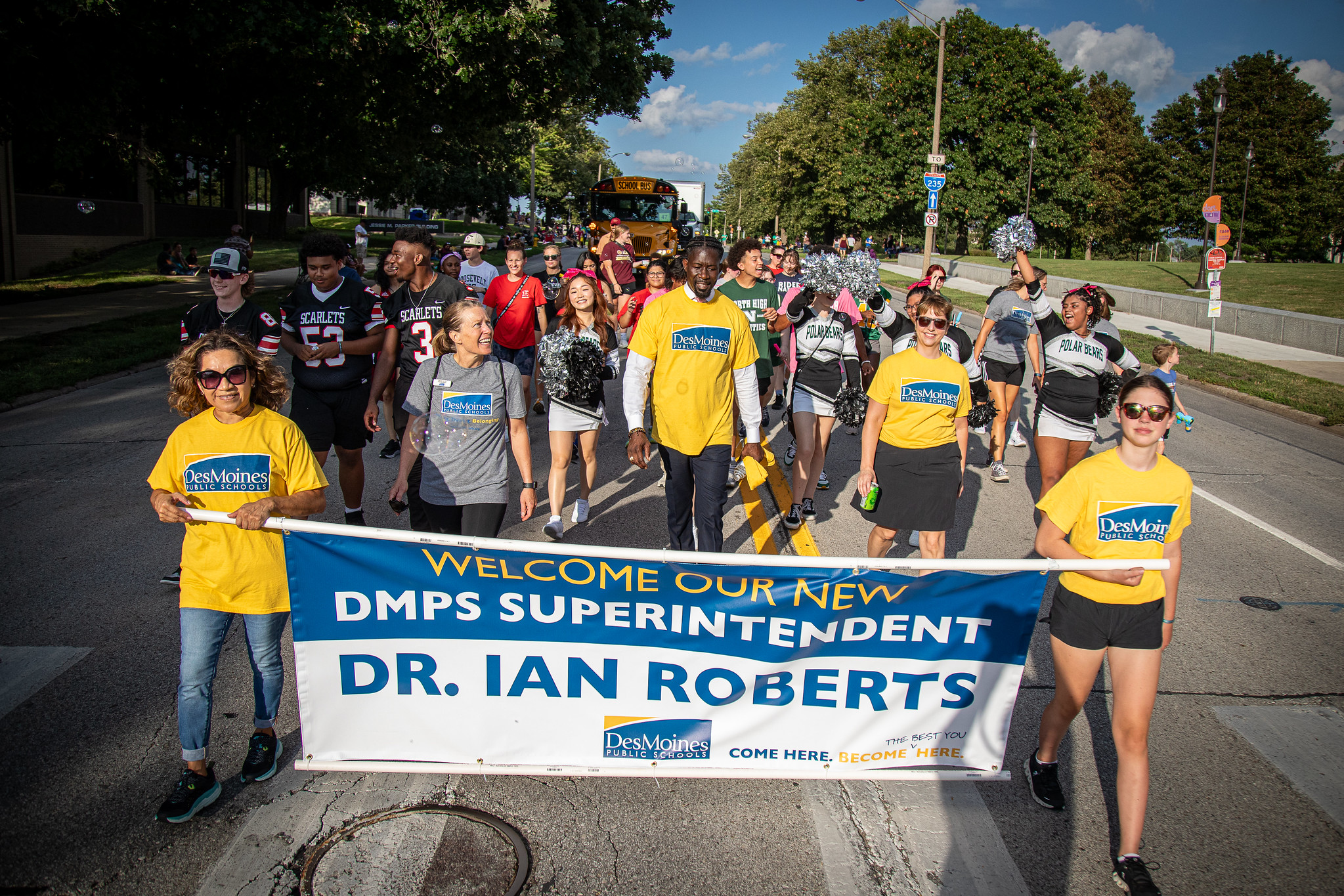Community engagement and input is a core value for the Des Moines School Board. In fact, it is a critical requirement in how the School Board goes about setting its goals for Des Moines Public Schools.
The School Board’s Governance policies (4.5.1.C-D) state that the Board will receive input from the community at least every three years to inform the goal setting process, and help determine which goals keep, modify, or end looking to the future.
Thank you to community members who have provided feedback and suggestions for the School Board to consider. Please see below for additional information on this work by the Board, including reports on the input and ideas gathered at a series of listening sessions as well as an online survey.
Laying the Groundwork (2018-19)
During the 2018-2019 school year, the Des Moines School Board facilitated public sessions that engaged parents, community members/partners, district staff, and students to collect information around two critical questions:
- What is the impact you want our school system to make on our students?
- What do you want students to know and be able to do?
This work led to the Board’s current goals. Now, with the public’s input and ideas, it’s time to look ahead.


Planning for the Future (2023-24)
This school year, the School Board led a series of public sessions to hear the community’s vision and values for our students. The Board listened to the community in order to affirm and/or consider any modifications to the current goals and guardrails. Information on two different ways to participate are outlined below.
The information gathered from both the public sessions and online survey is being collected, categorized and prioritized. The input, as well as a host of district data, will be reviewed and analyzed by the Board, the Superintendent and district staff. As a result of this process, the Board will create the goals and guardrails for the Superintendent and regularly monitor and adjust as needed, to best meet the needs of our students.
Over the next several months, with your input, this process will include three important phases:
- Community Engagement and Outreach Meetings and Survey
- Theme Development
- Board Goals and Guardrails Published
What You Shared With Us
The School Board is grateful for the feedback, input and ideas shared by people from throughout the community as a part of this process.
Starting in early December and running through late January, the School Board held community engagement and outreach sessions with 31 stakeholder groups and public gatherings. In addition, an online survey during that time received nearly 1,800 responses.
All of the input received – from both the in-person sessions and the online survey – is available to the public in the reports below:
- Analysis of the community listening sessions
- Listening Sessions – Raw Data
- Online Survey – Raw Data
- Summary of Other Data on Board Goals
NOTE: The above documents are all PDFs.


Input from the Superintendent
As a part of this process, the School Board asked Dr. Ian Roberts to share, as Superintendent, to share the areas of highest needs and the areas of highest leverage based on current data. Below is the information he shared with the Board in response to that request:
HIGHEST NEED AREAS
Areas of student performance where we are lagging as a district and need to further focus:
- High school graduation rates.
- Declining rates of Black males earning A or B in Algebra 1.
- Slowing growth from Semester 1 to Semester 2 Algebra I grades for Black males.
- Spring to fall drop in early literacy results.
- Increasing the hiring of BIPOC teammates through a refined system of recruitment and hiring on a national level.
- Increase the number of DMPS teammates who are culturally proficient based on the tenets of culturally responsive pedagogy and leadership.
- Chronic absenteeism at all levels (elementary, middle, high) in order to reduce from 36% district-wide.
- Additional supports with the implementation of Socio-Emotional Learning for students and adults.
- Improvement in the professional relationship between building and district teammates.
- Improved systems and structures which supports the career and industry-recognized workforce certification opportunities for DMPS students.
- A five-year strategic plan with a clear articulation of the district’s mission, vision, and key strategies.
- Middle school aMath results decrease as students move from 6th to 7th to 8th grade as well as decreasing from Fall to Winter within the same year.
- Overall high school academic performance of students.
HIGHEST LEVERAGE AREAS
Areas where we have traction, and the information is encouraging:
- Early elementary grades show strong universal screening results in both literacy and mathematics.
- Higher aMath proficiency among rising 6th graders is evidence of the success of elementary system.
- Middle school aMath shows small season over season improvements for all students (Fall 2023 to Fall 2024, Winter 2023 to Winter 2024).
- Consistent growth in Grades 2-3 FastBridge CBMreading for all students and Black male students from Fall to Spring of each school year.
- Consistent growth for students in K-8 ELL programming.
- Improving the morale of teammates through increased, improved, and transparent communication.
- Almost all Goals or Interim Goals are improving somewhat, but not yet at a rate of improvement sufficient to meet district targets.
- Year over year improvements in chronic absenteeism at all levels (elementary, middle, high).
- Additional supports with the implementation of Socio-Emotional Learning for students and adults.
- Growth in ACT Success rate from 2021-2022 to 2022-2023.
The Result: New Goals and Guardrails for DMPS
The process of setting goals and guardrails, as detailed above, includes gathering input from the community at public sessions and online surveys; gathering a host of district and school data; collaboratively reviewing and analyzing all of this information by the School Board, the Superintendent, and school district staff. (NOTE: videos of School Board work sessions, including work on establishing goals and guardrails, may be viewed on the DMPS-TV YouTube channel.) As a result, the School Board set goals in three priority areas: Early Literacy; Literacy for Black and Latinx middle school students; and Career Readiness. The communities’ values were also reaffirmed and updated into the five guardrails. The following goals and guardrails were adopted by the School Board on May 21, 2024:
GOALS
- Goal 1: The percentage of 4th grade students scoring proficient or advanced on the ISASP ELA assessment will increase from 50.1% in Spring 2023 to 65.0% in Spring 2027.
- Goal 2. The percentage of Black and Latinx 8th grade students scoring proficient or advanced on the ISASP ELA assessment will increase from 38.5% in Spring 2023 to 55.0% in Spring 2027.
- Goal 3: The percentage of DMPS Seniors by the end of their fourth year of high school who have achieved four or more of the DMPS Future Ready indicators as measured by the DMPS framework of Enroll/Employ/Enlist will increase from xx% in xxxx to yy% in yyyy.
GUARDRAILS
- Guardrail 1: The Superintendent shall not allow inequitable access for ELL students, or the continuation of systems that allow for it.
- Guardrail 2: The Superintendent shall not allow the social emotional learning needs of staff and all students to be unaddressed.
- Guardrail 3: The Superintendent shall not allow the composition of the teaching and learning staff to diverge from the diverse demographics of the student population while utilizing equitable and inclusive hiring practices conducted in accordance with cultural responsivity.
- Guardrail 4: The Superintendent shall not allow an environment in the classroom for both students and staff that is psychologically and physically unsafe and unwelcome.
- Guardrail 5: The superintendent shall not allow an environment that allows families and viable community partners to be excluded, uninvited, and unwelcome into the district’s activities and endeavors.






